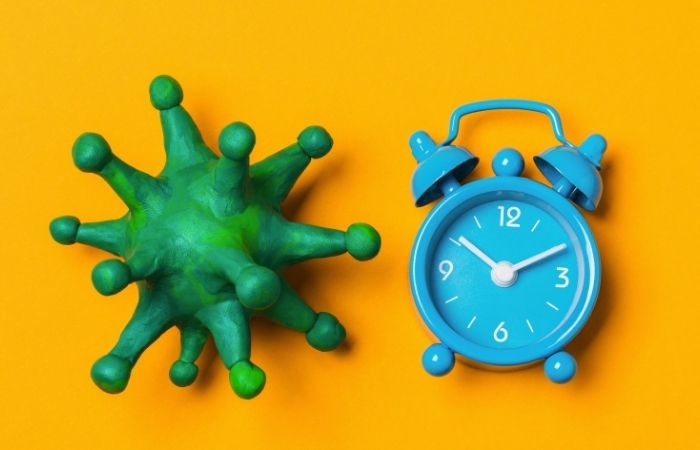The Science Behind Retesting: How Long Should You Wait?
Timing is everything.
Modern chlamydia tests (usually NAATs, nucleic acid amplification tests) are ultra-sensitive. So sensitive, in fact, they can pick up the DNA of dead bacteria for up to three weeks after successful treatment.
Here’s a timeline breakdown:
- 0–21 Days After Treatment: Don’t retest. High risk of false positive due to residual DNA.
- 3 Weeks to 3 Months: Retesting may show real reinfection or treatment failure. Retest only if symptoms return or a partner wasn’t treated.
- At 3 Months: CDC recommends standard retesting at this mark to catch reinfections, even if you feel fine.
Retesting too early is one of the most common mistakes and often leads to unnecessary anxiety and confusion.

People are also looking for... What Happens to Your Fertility After a Silent STD?
Could the Treatment Have Failed?
It’s rare, but it happens. Most chlamydia infections are treated with either a 7-day course of doxycycline or a single dose of azithromycin. The former is now preferred because it has higher cure rates and fewer resistance issues.
Reasons treatment might fail:
- Non-compliance: Missing doses or taking the medication incorrectly
- Antibiotic resistance: Very rare, but emerging in some regions
- Undiagnosed coinfections: If gonorrhea or other STDs are present, dual treatment may be needed
- Sex before partner was treated: Reinfection within the same cycle
The good news? If your provider thinks treatment failure is possible, they can prescribe a second course of antibiotics, sometimes with a different regimen.
When It's Actually Reinfection (and Why That Sucks to Admit)
This is the most common, and most painful, explanation.
You did everything right. You got tested. You took your meds. You abstained from sex (hopefully) for the recommended 7 days. But if your partner didn’t get tested, didn’t finish treatment, or had unprotected sex with someone else, you can get reinfected instantly.
Here’s what makes reinfection especially frustrating:
- Symptoms are usually absent: Most people with chlamydia have no idea they’re infected
- Partners feel “fine” and skip testing: Even well-meaning ones
- There’s no visible sign of reinfection: So it just feels like the first infection never ended
This is why mutual testing and clear communication matter, not because you don’t trust each other, but because you both deserve to know.
How to Protect Yourself from Repeat Positives
Repeat positives aren't just frustrating; they can be dangerous. Left untreated, chlamydia can cause pelvic inflammatory disease (PID), infertility, chronic pain, and increased HIV risk. Here’s how to protect yourself:
- Wait at least 7 days after treatment before having sex again
- Ensure all partners are treated, not just “say they will,” but confirmed
- Use barrier protection consistently until both partners have tested negative
- Retest at 3 months even if you feel fine to catch silent reinfections.
Also, don’t wait for symptoms. Get tested after every new partner, condom slip, or suspicion, even if it’s just to sleep better at night.
Check Your STD Status in Minutes
Test at Home with Remedium6-in-1 STD Test Kit

 For Men & Women
For Men & Women Results in Minutes
Results in Minutes No Lab Needed
No Lab Needed Private & Discreet
Private & DiscreetOrder Now $119.00 $294.00
For all 6 tests
How to Talk to Your Partner About a Second Positive Test
The first conversation was awkward. The second one might feel like a full-on crisis. How do you explain a second chlamydia diagnosis without sounding accusatory, or looking guilty?
Here’s your script starter:
“Hey, something came up on my follow-up test. It looks like I’ve tested positive again for chlamydia. I know we both thought this was handled, but it may have come back, or I may have been reinfected. Can we talk about what next steps we both need to take?”
Tips for a low-conflict, honest STD conversation:
- Lead with facts: Explain the testing timeline and medical reality.
- Drop the shame: Use neutral, science-based language.
- Use “we” statements: “We may both need to retest,” rather than “You gave this to me.”
- Be open to hurt and confusion: This conversation is emotionally charged; give them space to process.

People are also looking for: Is Your Teen at Risk? A Parent’s Guide to Teenage STDs
Silent Infections: Why "No Symptoms" Doesn’t Mean "No Damage"
One of the most dangerous things about STDs that affect sperm? They often show up without showing up. You could have chlamydia, gonorrhea, or trichomoniasis for months or years without a single burning sensation or discharge. But just because you feel fine doesn’t mean your reproductive system is.
Studies show that silent STIs can quietly damage the testicles, epididymis, and prostate. They inflame the delicate structures where sperm are made, stored, and transported. Over time, this can reduce sperm count, lower motility (how well sperm swim), or cause sperm DNA fragmentation, all without you ever noticing.
Don’t wait for symptoms. If you’re sexually active and trying to conceive now or in the future, regular testing is the only way to know what’s really going on.
The Sperm-Damaging STD No One Talks About: Trichomoniasis
When people hear “STDs that kill sperm,” they think HIV, gonorrhea, or maybe chlamydia. But trichomoniasis, a parasitic infection often dismissed as a “women’s issue”, deserves a seat at the table.
Recent research has shown that trich can live in the male urethra, prostate, and even semen. Once there, it causes inflammation, raises oxidative stress, and may directly impair sperm function. One study found that men infected with trich had significantly lower sperm motility and increased abnormal morphology.
The kicker? Up to 70% of men with trich have no symptoms. None. So unless you’re actively testing, you could be carrying around a sperm-killing parasite without realizing it.
Good news: Trich is curable with antibiotics, often in a single dose. Get tested and stop it before it wrecks your fertility from the inside out.
Semen Quality After Treatment: Can Your Sperm Bounce Back?
Let’s say you’ve had an STD, got treated, and tested negative. Now what? Is your fertility back to normal? The truth is, it depends on how long the infection lasted, how much damage was done, and how your body heals.
In many cases, yes, your sperm can recover after STD treatment. But it’s not always immediate. Studies show that sperm parameters (like count and motility) may take 2–6 months to normalize after clearing an infection.
Here’s how to help that healing process:
- Take a break from alcohol, tobacco, and hot tubs (all sperm killers)
- Eat foods high in zinc, vitamin C, and omega-3s
- Stay hydrated and manage stress
- Retest your semen if you’re trying to conceive
If things aren’t bouncing back, ask a urologist about doing a semen analysis and checking for scar tissue or blockages. Sperm damage isn’t always permanent, but time matters.
Check Your STD Status in Minutes
Test at Home with Remedium8-in-1 STD Test Kit

 For Men & Women
For Men & Women Results in Minutes
Results in Minutes No Lab Needed
No Lab Needed Private & Discreet
Private & DiscreetOrder Now $149.00 $392.00
For all 8 tests
Protecting Your Fertility: What Testing Looks Like for Sperm Health
STD tests aren’t one-size-fits-all. If you’re worried about sperm health, here’s what a smart, fertility-focused testing routine should include:
- Chlamydia and Gonorrhea: Urethral swab or urine test
- Trichomoniasis: Urethral swab or semen PCR testing
- Syphilis and HIV: Blood test
- HPV: Often overlooked, but semen-based tests exist
- Semen analysis: Not an STD test, but crucial for seeing the actual damage
Some at-home kits now offer expanded male fertility panels. These combine STD screening with DNA fragmentation and motility testing. It’s a discreet way to get real answers, without sitting in a cold clinic waiting room.
If you care about future fatherhood, don’t guess. Test smart, test often, and take your reproductive health as seriously as your sexual freedom.
Why People Don’t Retest, And How That Delays Treatment
Here’s the truth: most people who should retest… don’t. And it’s not because they’re irresponsible, it’s because they’re scared, confused, or totally unsure what “retesting” even means. The clinic may have told them to come back in 3 months, but what does that look like in real life?
“I thought I was fine after the antibiotics. No one explained I needed another test,” said Marcus, 29, who unknowingly passed gonorrhea to a new partner weeks after treatment. “It felt like I was supposed to just... guess.”
Here’s what often gets in the way:
- Fear of judgment: People feel ashamed to return to a clinic or admit they may have been re-exposed
- Logistics: Taking time off work, finding transportation, or accessing an LGBTQ-friendly provider can be major barriers
- False security: Many think one negative result = long-term safety, which isn’t true for high-risk exposures
That’s where discreet, at-home retesting becomes a game-changer. No pressure. No waiting room. Just clear answers, on your terms. And when your results come back, you don’t have to wonder if it’s too soon or too late. You’re taking charge right on time.
FAQs
1. Can you get chlamydia again from the same person?
Yes. If your partner wasn’t treated properly, or got reinfected elsewhere, you can catch it again even if you're monogamous.
2. Does a second positive mean the first treatment failed?
Not necessarily. Most likely, it means you were reinfected by a partner who was untreated or re-exposed.
3. How soon can I test for chlamydia after treatment?
Wait at least 3 weeks after completing antibiotics. Testing earlier can give a false positive due to leftover bacterial DNA.
4. Can chlamydia be dormant?
Chlamydia doesn’t “hide” long-term, but it can be asymptomatic, meaning no signs, but still infectious.
5. What if my partner refuses to get tested?
You can only control your health. Protect yourself with condoms and re-evaluate your boundaries if they refuse care.
6. Is it my fault I got chlamydia again?
Absolutely not. Chlamydia is common and can happen even when you're careful. This is about biology, not blame.
7. Do I need a different antibiotic the second time?
Not always. But if treatment failure is suspected, your provider may switch medications.
8. Can I still have sex after a second positive test?
Wait until you’ve finished treatment and any partners are tested and treated too. Otherwise, you risk ping-pong infections.
9. What are the chances of false positives?
Very low, but possible if you test within 3 weeks post-treatment. NAATs are sensitive to even dead bacteria.
10. How can I test discreetly without going to a clinic?
Use an FDA-approved at-home test kit from STD Rapid Test Kits. Fast, private, and accurate.
You’re Not Broken, You’re Being Proactive
That second positive result can feel like a punch to the gut, especially when you thought it was behind you. But let’s be clear: getting chlamydia again doesn’t mean you’re reckless, unlovable, or dirty. It means you live in a world where infections happen, testing matters, and partners sometimes don’t follow through.
Instead of spiraling, do this:
- Retest and treat again if needed.
- Have the awkward conversation with your partner.
- Use protection until both of you are cleared.
- Choose testing that works for your life and mental health.
You’re doing the right thing just by being here, reading this, and asking questions. And if you’re ready to take action now, STD Rapid Test Kits offers discreet, reliable options that put your health back in your hands.
Whether it's reinfection, lingering bacteria, or a testing fluke, you deserve answers, not shame.
Sources
2. Verywell Health – False Positive or False Negative STD Test Results: What to Know Before Retesting
3. PMC – Optimal Retesting Intervals for Urogenital Infections (Gonorrhea, Chlamydia)
4. BMC Infectious Diseases – Repeat Positivity and Reinfection: When Should We Retest Chlamydia?
5. Mayo Clinic – STD Diagnosis & Treatment: When to Retest After Treatment










